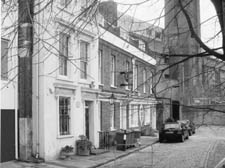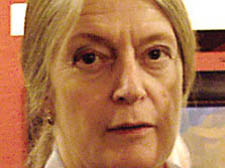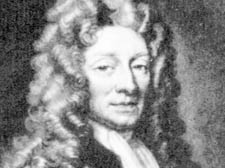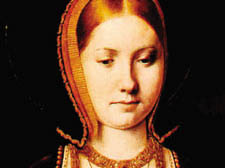|
|
 |
| |

Of the original Terrace, only No 49 has survived

Gillian Tindall

Tindall
proves Wren never lived at the house

One owner claimed Catherine of Aragon stayed there |
The House that Wren never really lived
in
Gillian Tindall’s brilliant
eye for detail is what makes the history of 49 Bankside so fascinating,
writes Jonathan Fryer
The House by the Thames
by Gillian Tindall
Chatto and Windus, £20
Taking a Sunday afternoon stroll along Bankside, on the southern
bank of the Thames opposite St Paul’s Cathedral, one could
easily miss the stuccoed façade of the Queen Anne house
at Number 49, were it not for the blue plaque proclaiming that
Sir Christopher Wren lodged there for a while, so he could view
the progress being made on his architectural masterpiece.
The irony is, as Gillian Tindall conclusively demonstrates in
the latest of her meticulous examinations of time and place
under the microscope, The House by the Thames, Wren never did
live there. Nor did Catherine of Aragon stay in the old inn
that the house replaced, as one of 49 Bankside’s various
owners once claimed, in the hope of boosting the property’s
commercial potential.
So why devote a whole book to one London house, whose most famous
genuine resident was the now virtually forgotten pre-War British
film star Anna Lee? Or the even more forgotten eccentric sometime
poet, waiter and war correspondent Guy Munthe, who used to career
round town on an ancient motorbike, his pet parrot Augusta tightly
gripping the handlebars?
The answer lies in the detail: the small, seemingly insignificant
element or observation that Ms Tindall can scrutinize and elaborate
on until a much more substantial tableau emerges.
After an early debut as a novelist, this Kentish Town writer
has turned herself into the Miss Marple of English and French
social history.
Painstakingly working through dusty archives, or interviewing
people with some tangential connection to the subject at hand,
she constantly astonishes with original revelations or analyses.
Her probings into part of Camden’s past still provide a
useful guide to the borough’s residents in search of their
neighbourhood’s background, while in her adopted second
home, France, she is lauded for her unveiling of obscure but
telling local histories.
Gillian Tindall obviously relishes the search and the joy of
chance discoveries. One can sense her delight – spiced
with a certain appealing self-mockery – when she declares
at one stage in this book, “in the pursuit of 19th-century
drawings, I chanced upon a set of flood prevention plans of
1881.” Those plans provided a detailed frontal view of
a whole terrace of Queen Anne buildings on Bankside, of which
only number 49 has survived.
That it did so was more by accident than design. At various
stages in its long life, the house fell into dilapidation, became
infested with rats, was split into tenements and, most humiliatingly
before the regeneration of the South Bank, was occupied by squatters.
Ms Tindall does not dwell exclusively on the house itself, or
even on earlier buildings located on the precise site. Rather
she allows her curiosity to wander along and across the Thames,
while particularly focusing on Southwark, over a period of several
centuries.
Noting the bear pits and pleasure gardens that preceded the
theatres of Shakespeare’s day, as well as the importance
of the river trade and cargo unloading and the development of
the power industry from coal to electricity, she produces a
complex tapestry that nonetheless illuminates the past with
a simple clarity.
When marshaled by her expert touch, apparently random facts
suddenly display a logical progression or connection as one
activity or family involvement seems to predestine what happens
next.
As the author notes in a key passage in the book: “Thus
do patches of London’s ground, which are nothing in themselves
but gravel and clay and river mud, and the ground-down dust
of brick and stone and bones, wood and wormwood and things thrown
away, acquire through ancient incidental reasons a kind of generic
programming that persists through time.”
It is odd, though, that such a prime site as Bankside should
have remained so untouched by civic pride and pomposity until
the conversion of the former power station into Tate Modern
and the building of the Millennium Bridge. As Ms Tindall points
out, in most continental capitals, the land would have been
earmarked for a grand administrative building, a university
or an opera house.
But it is an undeniable fact that, until recently, this part
of the South Bank was not even thought of as London at all,
but rather as an urban extension of Surrey.
Moreover, for a long time it was the place where things went
on that would have been seen as unseemly in the City of London
on the northern shore, with its plethora of churches and upright
merchants and bankers.
Indeed, until Henry VIII (of all people!) closed the Bankside
brothels down, this area of Southwark was as famous for its
‘Winchester Geese’ – prostitutes who lived metaphorically
in the shadow of the London residence of the Bishop of Winchester
– as it was for the bull and bear-bating.
Such salacious details pepper The House by the Thames, and as
Gillian Tindall admits at one stage “everyone likes hearing
about ancient vice”. But there is virtue as well as vice
in this book; on occasion, even pathos.
Among the diverse cast of characters who lived at Number 49
over the years was a disabled girl who was essentially trapped
in top-floor lodgings there, where she financed her survival
by boiling sweets on a stove. Did death or poverty lead to her
eventual departure?
Such tantalising questions have to remain unanswered. But in
the case of a much later resident, the debonair Times leader-writer
Peregrine Worsthorne, thanks to this book we know that his departure
from 49 Bankside was prompted by catching a rare form of jaundice
from the rats.
|
|
 |
|




